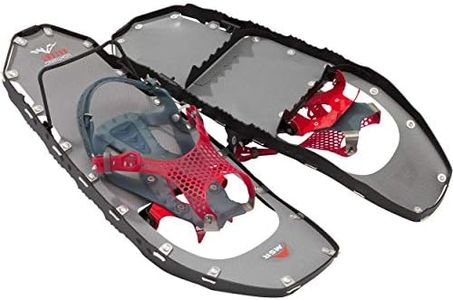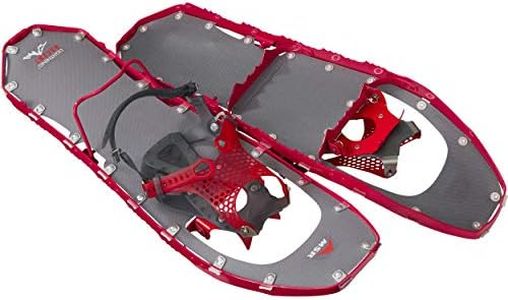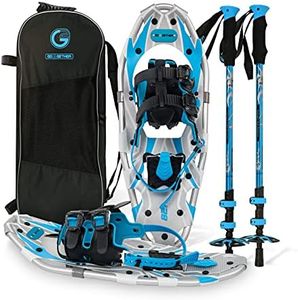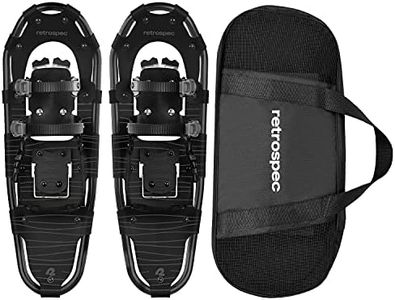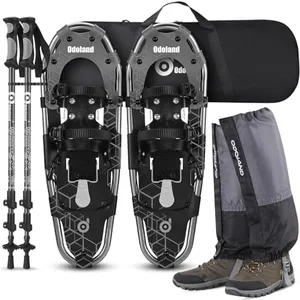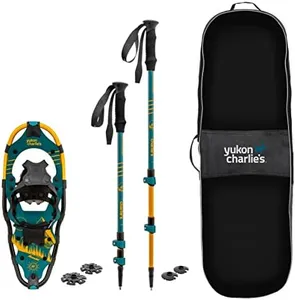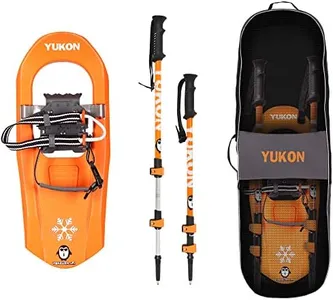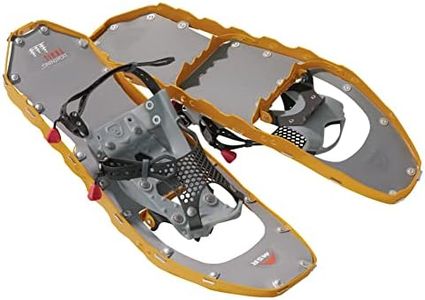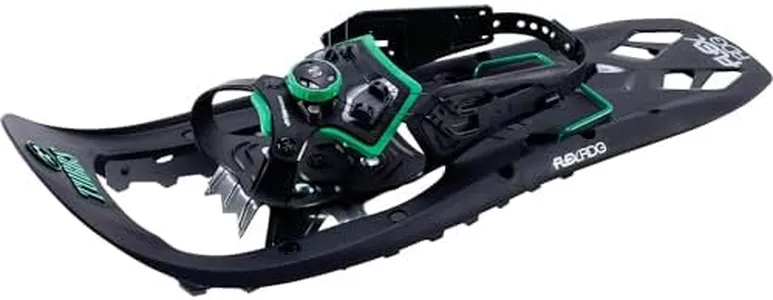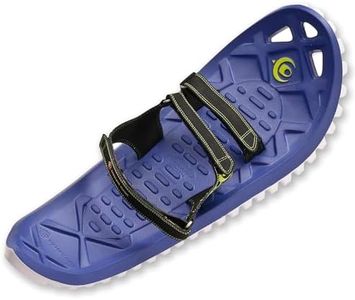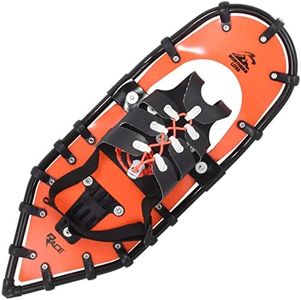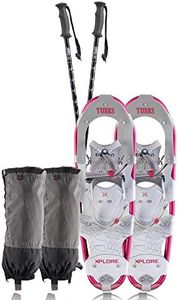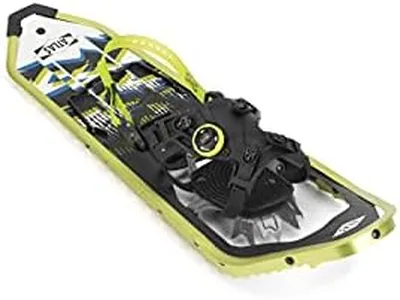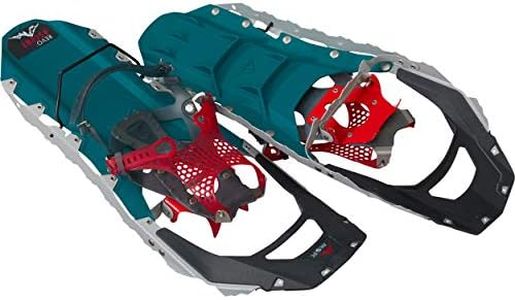10 Best Snowshoes For Women 2025 in the United States
Our technology thoroughly searches through the online shopping world, reviewing hundreds of sites. We then process and analyze this information, updating in real-time to bring you the latest top-rated products. This way, you always get the best and most current options available.

Our Top Picks
Winner
MSR Lightning Ascent Backcountry & Mountaineering Snowshoes with Paragon Bindings, 22 Inch Pair, Black
Most important from
130 reviews
The MSR Lightning Ascent Backcountry & Mountaineering Snowshoes are a solid choice for women who are serious about mountaineering and tackling rugged terrains. At 22 inches long and weighing just 4.18 pounds per pair, these snowshoes are ultralight, which is a big plus for reducing fatigue during long treks. The alloy steel frame material is durable, and the 360-degree Traction Frames along with the steel DTX crampons provide excellent grip and stability on various surfaces, particularly useful on steep slopes and icy conditions.
The Paragon bindings are designed to wrap securely around your boots, offering a comfortable fit without pressure points, which is great for long-term wear and foot control. The Ergo Televator heel lift bar is another thoughtful feature, making uphill climbs more efficient and less tiring by reducing strain on your calves. However, the maximum weight capacity of 180 pounds may limit their use for heavier individuals, especially when carrying a backpack. Additionally, while the bindings fit a wide range of shoe sizes, the one-size-fits-all approach might not provide the perfect fit for everyone.
Despite these minor limitations, these snowshoes are well-suited for women who enjoy backcountry and aggressive mountaineering pursuits, offering a balance of lightweight design, robust traction, and comfort.
Most important from
130 reviews
MSR Lightning Ascent Women's Backcountry & Mountaineering Snowshoes with Paragon Bindings, 25 Inch Pair, Raspberry
The MSR Lightning Ascent Women's Backcountry Snowshoes are designed for outdoor enthusiasts looking for a lightweight and high-performance option for winter hiking in challenging terrains. Weighing in at just 4.04 pounds for the pair, they excel in providing mobility and ease of use, especially for women with a narrower stride. The tapered frame and 360-degree traction ensure excellent grip, which is crucial when navigating steep or icy surfaces. The durable steel DTX crampons offer reliable traction, making them a solid choice for alpine adventures.
One of the standout features is the Paragon bindings, which provide a snug fit without causing discomfort—this is a significant plus for long hikes. The glove-like feel allows for better foot control, while the Ergo Televator heel lift bar enhances uphill efficiency, reducing fatigue during steep climbs.
Potential buyers should consider that these snowshoes are best suited for those who weigh up to 220 pounds. Those who might need to carry extra gear or exceed this weight limit may want to look at larger options. Additionally, while the materials used are durable, the plastic components may not hold up as well in extremely rugged conditions compared to completely metal options.
The MSR Lightning Ascent snowshoes are an excellent fit for women who enjoy backcountry snowshoeing and seek a lightweight, user-friendly design that emphasizes comfort and traction. They are particularly well-suited for winter hiking in mountainous environments, making them a great choice for outdoor adventurers looking to tackle snowy trails confidently.
Tubbs Snowshoes Mountaineer W, Purple, 25 (X19010010125W)
Most important from
111 reviews
The Tubbs Snowshoes Mountaineer W in purple is a solid choice for women looking to explore snowy terrains. With a Pro-Step frame and Soft-Tec decking, these snowshoes offer a good balance of durability and flexibility, making them comfortable for various snow conditions. The aluminum frame keeps the weight down, weighing only 1 pound, which is excellent for long hikes where every ounce counts. The ActiveFit 2.0 binding is designed to provide a secure fit, and the EZ Heel Buckle makes it easy to adjust. The traction features, including the Anaconda Toe and Python Heel Crampons, ensure stability on icy surfaces, which is a crucial factor for safety. The ActiveLift 19° heel lift is another highlight, as it enhances comfort and reduces fatigue on inclines.
The maximum weight capacity is 91 kilograms, which may not be suitable for all users. The product's popularity rank indicates that there are many options available in this category, so potential buyers might want to compare with other models.
The Tubbs Snowshoes Mountaineer W is a well-rounded option for recreational female snowshoers, balancing comfort, safety, and performance. It’s best suited for those who enjoy moderate snowshoeing and do not exceed the specified weight limit.
Most important from
111 reviews
Buying Guide for the Best Snowshoes For Women
Choosing the right pair of snowshoes is essential for enjoying winter hiking and trekking. Snowshoes help distribute your weight over a larger area, preventing you from sinking into the snow. When selecting snowshoes, it's important to consider various factors such as the terrain you'll be exploring, your weight, and the type of activities you'll be doing. Here are some key specifications to help you make an informed decision.FAQ
Most Popular Categories Right Now
